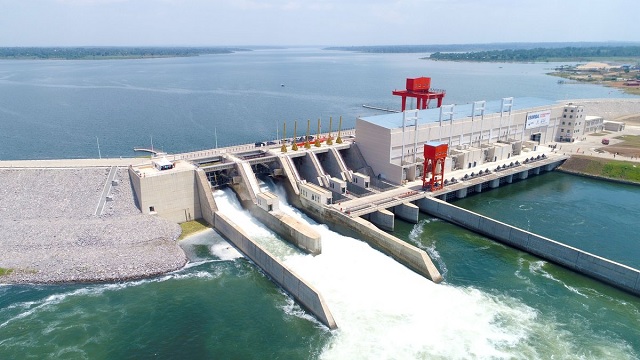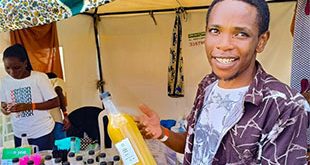
Ugandan government has in the past years faced harsh criticism over regular borrowings from China Import Export Bank to facilitate development of infrastructure projects including hydropower dams, roads and possibly soon the planned Standard Gauge Railway. But the Chinese loans have also had a fair share of positive aspects to the population as Isaac Khisa reports.
Little more than five years ago, Busana and Nazigo sub-counties in Kayunga District, located approximately 85km east of Uganda’s capital, Kampala, were typical ‘African backwaters.’ Residents here struggled to survive as subsistence farmers; fetched water from River Nile for domestic purposes including drinking and cooking food.
They also had to cope with the narrow and dusty access roads, some only good for pedestrians.
A similar state played out in the adjacent sub counties on the eastern banks of the Nile in Kamuli District which shares the dam.
Kamuli is where the former Speaker of Parliament, longest serving and most powerful parliamentarian and now the First Deputy Prime Minister and Minister for East African Community Affairs, Rebecca Alitwala Kadaga, comes from.
But the people’s fortunes on either side of R.Nile have extremely changed. The construction of the Chinese-funded 183MW Isimba Hydropower Dam across the Nile at a cost of US$568million with the China’s Exim bank providing 85% of the funds as a loan, has seen the government ramp-up infrastructure developments in both districts, a development that wouldn’t have happened without the new dam.
The situation is similar for residents in the districts hosting 600MW Karuma Hydropower Power Dam further downstream on R. Nile, located in Kiryandongo District in mid northern Uganda, 110km downstream of Lake Kyoga and 270km from Kampala.
Isimba Hydropower Dam, whose construction started in 2013 was commissioned in 2018 while Karuma Hydropower Dam is expected to be commissioned in June 2022. These developments have been described as a ‘game changer’ in the country’s energy sector and a big boost to the industrialization as well as promotion of the East African Community (EAC) as more electricity will now be exported to the neighbouring Kenya and power South Sudan.
Economic dividends
However, these investments have also come up with new developments riding on the dams’ construction. More than seven learning institutions – primary, secondary and technical schools – now have new classrooms, dormitories and sanitary facilities, or have their old infrastructure refurbished. Health centres, too, have received a fair share of this so-called transformation though still plagued by inadequacies in essential drugs and human resource.
The only main road that links Kayunga and Kamuli districts now has some patches of tarmac as construction work is ongoing. The residents in the two districts also have a bridge that has replaced the outdated and unreliable ferry facility popularly known by the locals as Nabukeera.
From the dam’s construction site towards Busana Town Council, about 2 kilometres away, there is clear evidence that the dam has had an economic windfall.
Mawa Barasa, a hardware operator at Busana Town Council said the new dam sparked off the development of improved housing units and businesses.
“We no longer have dust here. We also have new investments in housing and so the demand for cement is high,” he told The Independent in an interview. “Majority of us now have electricity and this would not have been possible without the construction of Isimba dam.”
Mawa added that it is now easier to travel between Kamuli and Kampala via Kayunga due to improved road network and the new bridge. He, however, says the new developments have also come with their own challenges.
“Prices of some products that we used to get from Busoga sub-region (which includes Kamuli District) via the ferry like maize flour and sugar have gone up. This is because traders now prefer to sell their products to us at ‘Kampala prices’ which are slightly higher compared the periods before the construction of the dam,” Barasa said, adding that the current good road network is to blame.
Simon Anguyo, a taxi driver plying the Kayunga-Kamuli Road says whereas the road network connecting the two districts has improved and thus easing their movement, new taxis have also joined the route increasing the competition.
“We no longer inhale the dust as it used to be before. The travel time has also reduced by more than 50% and this is good for us and the passengers,” he said.
Further downstream on R. Nile in mid-northern Uganda, the areas hosting Karuma Hydropower Dam, have also recorded similar developments.
Jacob Ateenyi, a Member of Parliament for Kibanda South County in Kiryandongo District which hosts the dam besides Oyam and Nwoya Districts confirmed that indeed the social-economic status of some people there has improved.
“Karuma trading centre wasn’t like this. There’s a lot of businesses now, new towns have come up and even grown faster than the older ones, and I am sure that when the dam is completed and people have economic power, they will develop much faster,” he said.
“We are sure these (houses) are going to host a number of people when the dam is commissioned, and obviously will come with some money which will boost the economic status of this place. Some of them (workers) will remain, buy land and invest here.”
Ateenyi said some of their children have been employed in the dam construction and the lucky ones have been able to build houses and improve their lives.
Francis Okello, a business man at Karuma town dealing in beverage products reiterated that Karuma trading centre has had tremendous transformation since the construction of the dam began eight years ago.
“There was a lot of money here especially every end of the month,” he said, adding that he was able to buy a plot of land and build his home using proceeds from the booming business at the time.
These developments have also prompted the country’s tourism agency to start planning on how to reap some fortunes around the dam.
Lilly Ajarova, the Chief Executive Officer at the Uganda Tourism Board (UTB) recently revealed that her organisation has since signed a memorandum with the Uganda Electricity Generation Company Limited (UEGCL), the government agency responsible for construction and management of the power dams, to transform the two dams into infrastructure tourism destinations.
“The successful development of Karuma and Isimba dams into tourism sites will further diversify our tourism portfolio and, therefore, contribute to our core objectives like sustainably increasing the volume and value of tourism to Uganda and by extension,” she said last month.
 The Independent Uganda: You get the Truth we Pay the Price
The Independent Uganda: You get the Truth we Pay the Price





